How we grew our startup from $400 to $2,750 MRR in 135 days without ads
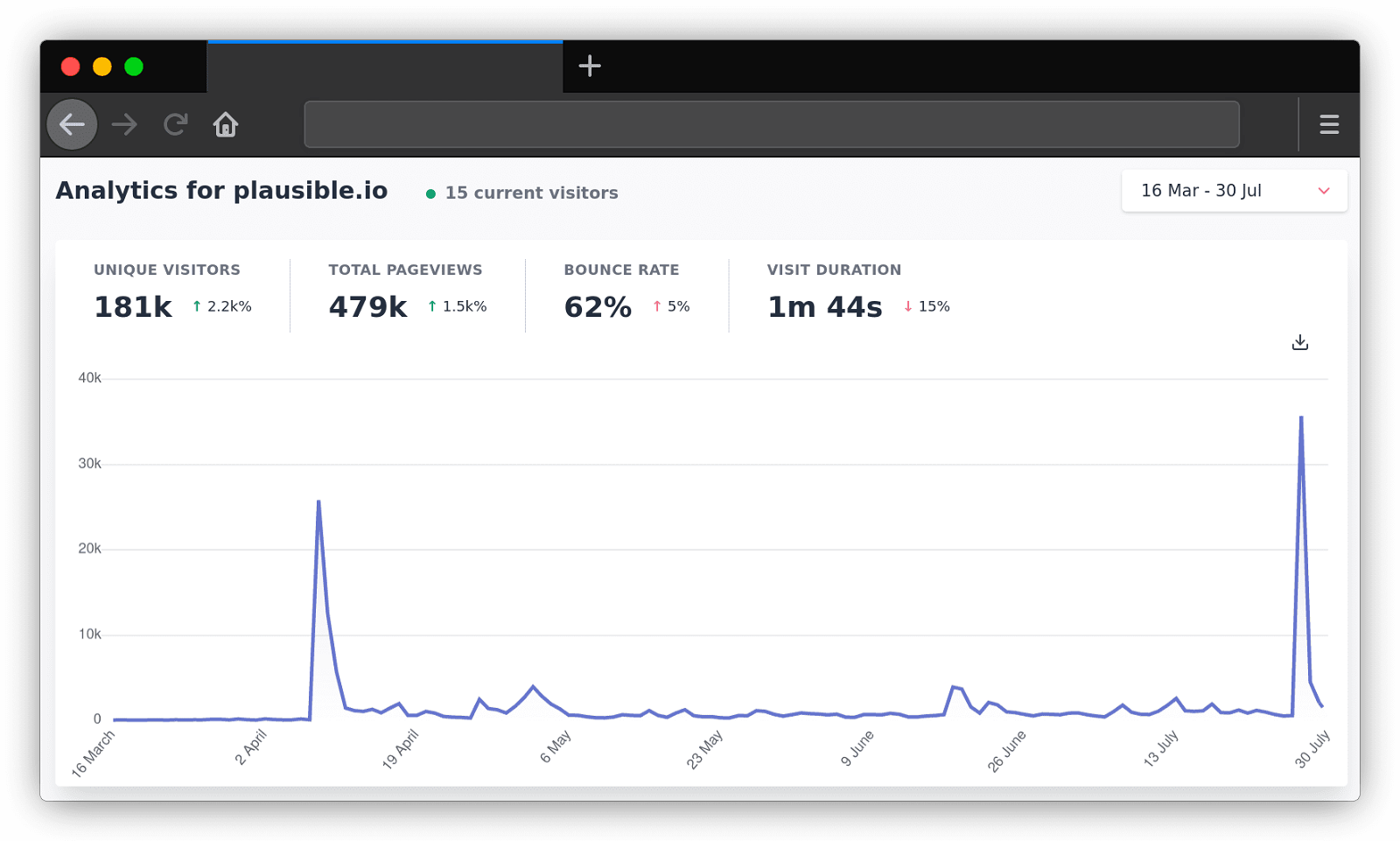
The last few months have been remarkable for Plausible Analytics. We got more than 180,000 visitors in this period which is a 2,200% increase compared to the prior period. We also saw 10x more trial signups and a 690% increase in subscribers.
As we’re bootstrapped, all this was done without any paid advertising, affiliate marketing and other sponsorships. We’ve focused on organic ways to drive brand awareness and business growth. Here’s a brief overview of our recent milestones:
- April 2nd: We announced that we reached $415 MRR
- May 12th: Reached 100 paying subscribers in 364 days since we opened up for subscriptions
- May 27th: $1,000 MRR
- June 11th: 200 paying subscribers
- July 6th: Reached $2,000 MRR and 300 paying subscribers
- July 30th: $2,750 MRR and 427 paying subscribers
Our conversion rate is incredibly high. We have a 30-day free trial with no credit card upfront. Our trial to paid conversion rate for April and May cohorts combined is 33.5%.
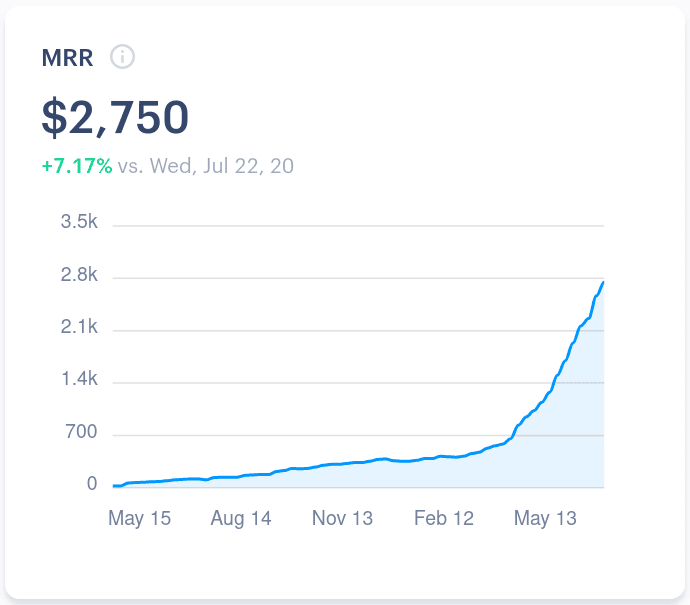
This post will focus on all the actions we took since I joined Plausible Analytics as a co-founder to focus on the communication and marketing side of things. Let’s start.
- Start with a product that sells itself
- Ride the wave
- Main marketing decision is about which options to say no to
- Understand the audience you are trying to reach
- Position your startup against a market leader
- Keep it simple, stupid and make the communication direct and clear
- Start publishing useful supplementary content
- Start publishing interesting blog posts
- Talk to people
- A look at our top referral sources
- What do we plan to do next?
Start with a product that sells itself
My co-founder Uku has built a great product that speaks for itself and makes the marketing job much easier.
It is simple to use, beautiful to look at and naturally differentiates itself as a great Google Analytics alternative in several ways. All this helps when communicating about the benefits of using the product. And it drives word-of-mouth as many of the users love the product so much that they share it with their friends and networks.
If the product is not easily differentiated from the rest of the market, it makes marketing so much more difficult. That puts the marketing people in a situation where they have to get very creative with the copy which is not necessarily based on the facts. That is bound to overpromise and underdeliver. We don’t have those problems.
Ride the wave
It is much easier to promote a product if it rides a wave of a growing market interest. And Plausible Analytics is riding a rising trend:
-
More website owners are becoming increasingly aware of the different privacy issues around websites analytics and user tracking
-
GDPR, CCPA and other privacy regulations have certain requirements for website owners around needing to give visitors options and get their consent
-
Having a fast loading and speedy website makes the user experience much better especially on mobile phones and it is even a signal for search engine algorithms
Plausible Analytics provides a great and simple solution for all of the above. It is privacy-first, compliant with the different regulations and 75 times lighter than the market leader.
Main marketing decision is about which options to say no to
Some marketers embrace the “be everywhere” approach. They are represented on all the main social media networks, they chase the growth on upcoming platforms and so on.
As a bootstrapped startup, resources are limited. You simply don’t have enough time, money nor people to do everything, be everywhere and follow all the recommended marketing practices.
Here’s what we do:
- We only have active social media profiles on Twitter and Mastodon
- We put the majority of our marketing efforts into creating and publishing content
And here’s what we don’t do:
- We don’t do paid advertising
- We don’t track your every step and every click watching your sessions
- We don’t do A/B testing
- We don’t have spy pixels from Facebook and Google so we can retarget you
- We don’t try and collect your data in exchange for some freebies
- We don’t have a podcast
- We don’t do videos
- We don’t have a fancy email sequence where we try to “nurture” you into paying
- We don’t do any intrusive popups
There is nothing inherently wrong with some of the above and these tactics can be very successful for some startups but they all take a lot of time to be implemented properly.
And that’s difficult to achieve especially if you’re just starting out or if you’re a bootstrapped with limited human resources. If you try to follow all the best practices and do everything, you may very well end up not doing any of it well enough and failing.
You need to pick your spots, choose a selected few tactics that make sense to you and ignore everything else until you have more capacity. Those tactics that you do pick, make sure you commit to being consistent on. Excel at those first and consider adding more later on.
Understand the audience you are trying to reach
I started working with Uku on March 16th this year. The first actionable step we took was to address the home page and the positioning of the product. To do this, you need to have a good understanding of the market you are in, what the needs of the market are and the position that your product plays in the market.
You can do market research to understand what the demand is and what gaps there are. It helps that you think like the audience you’re trying to reach, that you’ve had a similar experience, been in a similar position and that you can be in their shoes. Think about your target audience:
- Who are they?
- Where are they spending their time online?
- What questions do they want to get answered?
- What issues do they face?
- What are their pain points?
Position your startup against a market leader
You really need to work hard on figuring out what makes you stand out in the crowded market. What makes you different from the other products in your industry. The common angle of looking at a market is no longer of any real interest. You should add an angle on an angle.
- Do you make boring concepts exciting?
- Do you make complicated things simple?
- Do you make intimidating solutions painless?
The best way to position your startup is against something that many people are aware of. Pretending that a popular competitor and a market leader doesn’t exist is something I’ve noticed many startups do. It’s a mistake.
You’ve probably visited a home page of a startup and immediately understood the market they are trying to serve and the big competitor they’re up against. In your head, you’re probably comparing what you see on their site to what you know about the competitor.
But on their home page, there’s no mention of that competitor at all and no clear positioning against the competitor. They’re not trying to help you figure out what differentiates them and what makes them better from the product that you already know.
In our old copy, we didn’t focus on the fact that Google Analytics exists and that most of the people who may want to consider Plausible Analytics have at least some experience using Google Analytics. Google Analytics is installed on the majority of websites after all.
We made a change to our website and positioned ourselves directly and clearly against Google Analytics on the aspects where we think they’re not doing as well and where we think we might have a better solution for some site owners.
We improved the design too and included a large image close to the top that showcased the product. We’ve done the same with pricing where we added additional tiers to make the product more affordable and introduced a yearly billing with a 33% discount too.
We went from this where the main headline was: “Simple analytics for your website”, to what you see on our home page right now where the headline is “Simple and privacy-friendly alternative to Google Analytics”.
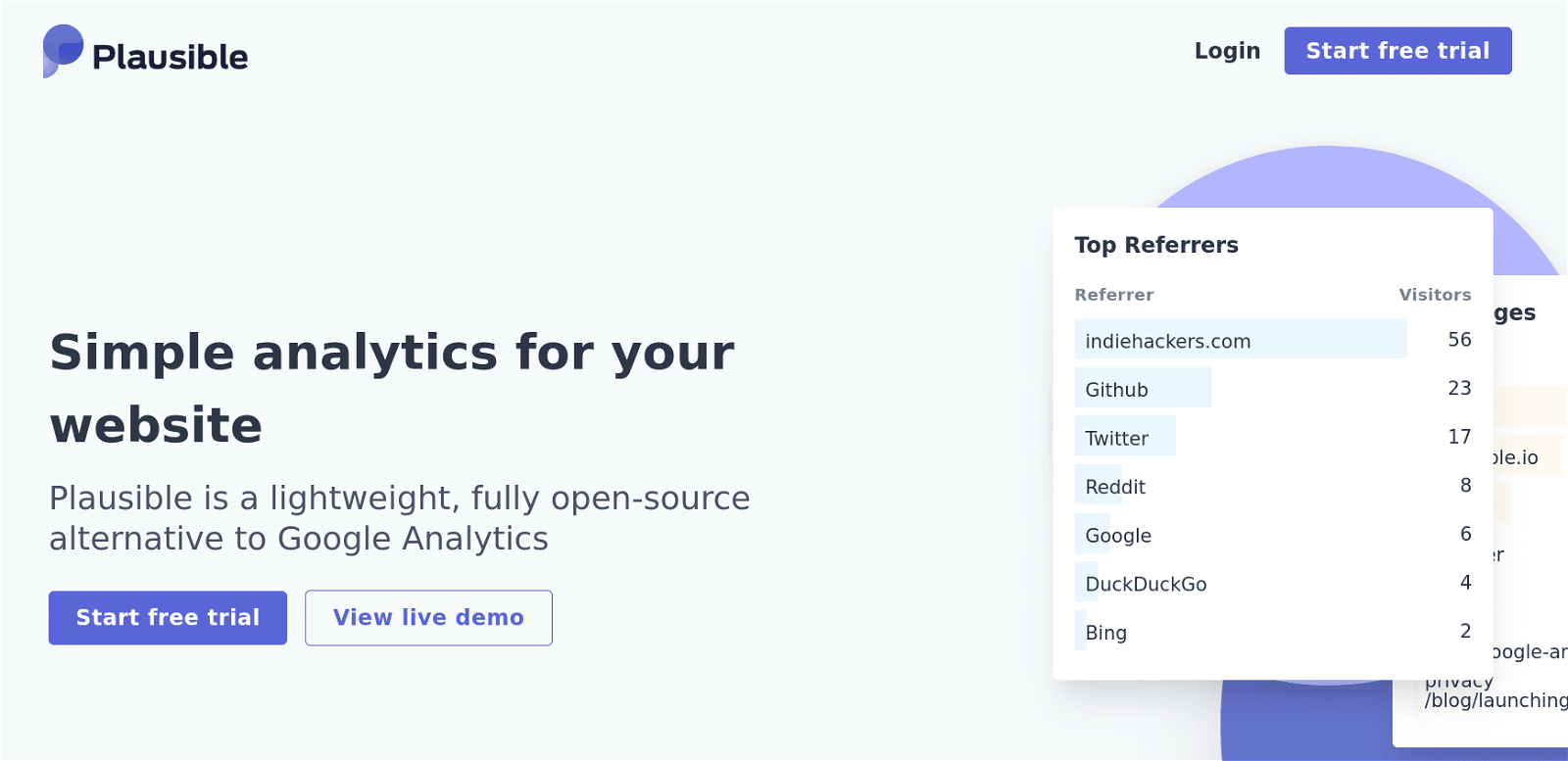
Keep it simple, stupid and make the communication direct and clear
In addition to the changes to the home page, we tried to make the communication as clear as possible and we tried to simplify whatever we could. All this helps get the message across to more people and helps them have a nicer user experience.
We went through every key step and looked at it from a fresh perspective. The perspective of a person just entering our page for the first time. We added frequently asked questions with some useful information. We added copy to the registration page that explained the different details about our free trial.
We added an email flow that everyone who signs up for a trial gets. Nothing too fancy, more informational such as telling the trialist that their website is now being tracked or that their trial is about to expire.
You may believe that people love your product and that they’ll check it every day or be aware of when their trial is expiring, and that may very well be true in some cases, but in the majority of cases, a bit of information here and there helps.
Start publishing useful supplementary content
We didn’t stop at changing the home page copy. We added several more product pages which were not necessary just selling the product but were more focused around the different needs people have and how Plausible Analytics is built to address those.
From using Google Analytics ourselves in the past to speaking to other Google Analytics users, we came up with several different categories and pain points where we believe we have a valid alternative. Here are some examples of pages we published:
-
Ease of use - Google Analytics is famous for having hundreds of different reports/metrics and many people struggle to understand and get value from it. Our tool gives all metrics at a glance.
-
Website speed - Google Analytics tracks a lot of data so if you insert their scripts on your site, it may affect the page loading speed. Our script is lightweight so it has a tiny impact on site speed.
-
Privacy regulations - Google Analytics uses cookies and tracks personal data so your site needs to have cookie banner and prompts to get GDPR consent too. Our tool is compliant with the privacy regulations out of the box.
And a few more such as one focused on how we help agencies and freelancers better serve their clients. We published 8 product pages in total with more than 1,000 words in each. Full of interesting and useful content rather than salesy stuff. You can find them all in our top menu.
This helps make our site more complete. It gives potential users more information about us when they’re doing their research. And it gives search engines more content that they can index which gives us additional ways to get discovered by more people.
Start publishing interesting blog posts
Then we started publishing blog posts. I published my first blog post on April 8th and it was titled “Why you should stop using Google Analytics on your website”. That went well across the different communities.
Our more recent post on ways to fund open source projects has done just as well. We’ve now published 15 blog posts since the start of April which makes it approximately one per week. Again, none of these posts were salesy and promotional.
They all focused on a pain point, a question people have or a trending but relevant topic. We covered many interesting topics relevant to web analytics, open source and the different privacy regulations.
The main idea is always to include a lot of useful and interesting information first, to answer the questions people have, to solve their issues and indirectly introduce them to Plausible Analytics.
We do some research on a relevant and timely content topic and try to write a longer article that answers all the different questions people are asking about that topic. Our research is mainly based on Google’s search results. For every post we look at these different areas of Google’s results:
- Google autocomplete for search queries people search for
- “People also ask” section which lists a lot of relevant questions people frequently ask
- “Searches related to” gives an additional list of related topics to cover
Between these three sections, there’s a lot of questions to answer and other ideas for different things to include in an article. It all helps create a longer and more complete post that looks at a topic from several different angles.
We went from getting just over 400 clicks in the period before April and more than 6,000 in the period since. Many of these articles are now slowly sending us a click or two from Google every day which accumulates. And most importantly they help us rank our home page too. You can see here the list of keyword phrases people found us with on Google.
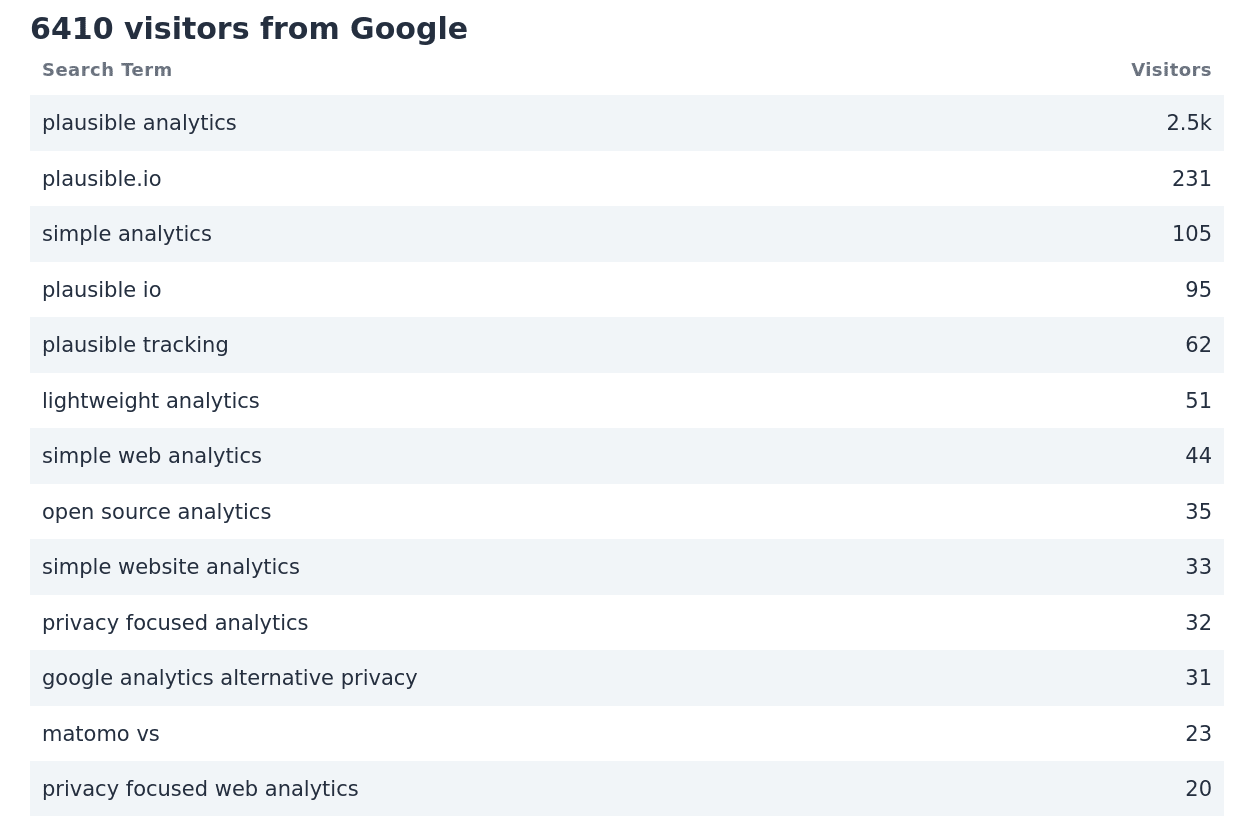
Talk to people
A large part of my day is spent on talking and engaging with people. This includes responding to emails, social media and other messages that we get, but also includes proactively reaching out to other people too.
Reach out to relevant people
Our most successful day in terms of new trial signups was on May 2nd with 94 new trials. This was when we published a post on Opensource.com. This opportunity came from cold outreach.
Opensource.com had previously published a post about open source alternatives to Google Analytics and as that is very relevant to us we reached out to see if there was a way to get Plausible Analytics added to the list.
They liked our product and suggested that we write a post about Plausible Analytics instead and so we did.
We have reached out to several other sites too. In most cases, you will be ignored but if you do contact only the most relevant sites to what you’re doing and you do it without trying to sell anything, you may get a decent rate of responses.
Invite yourself to be a podcast guest
We were invited by the Changelog team to be a guest on their podcast after they read our post about how one post changed the traction of our startup.
This was a great opportunity for us to get our message across to a large and relevant audience. Changelog even ended up installing Plausible Analytics on their website.
You could reach out to relevant podcasts, tell them what’s interesting about your story and invite yourself to be a guest. Or you could publish a blog post with your story, get some traffic to it and wait for the invites to start coming in.
Engage with people looking for your solution
One of the things I do is to use Twitter search to find people that are looking for solutions to the problems that we are solving and for people talking about relevant topics to web analytics.
I use TweetDeck to search Twitter for a variety of relevant keywords about Google Analytics and I try to interact with many of those who are looking for an alternative or who have frustrations with Google Analytics.
This introduces us to new people, helps us get great feedback and in many cases gets the people to give Plausible Analytics a chance. It is also one of the main reasons why Twitter is our second highest source of traffic. Let’s take a look at our top traffic sources.
A look at our top referral sources
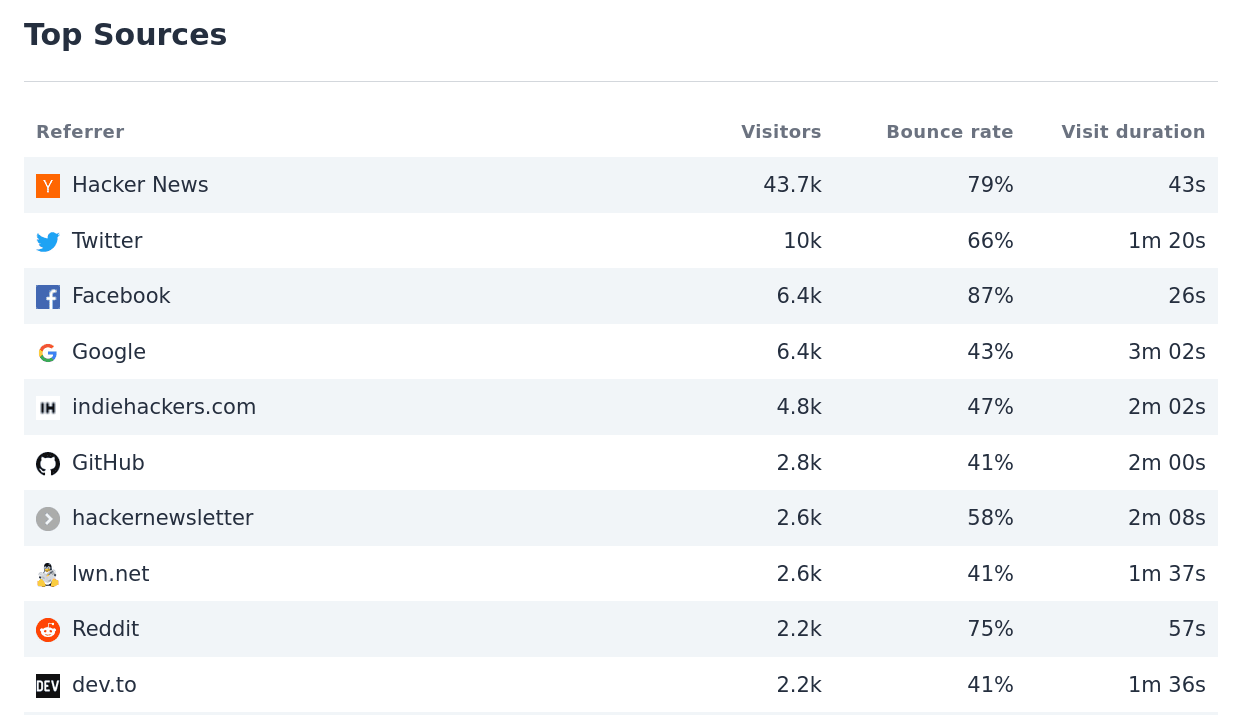
Many startup founders struggle to figure out what to do to get some attention and drive some traffic when starting. Here’s the list of our top 10 referral sources and some comments on each. You can also see it on our open stats dashboard.
Hopefully this can inspire you to new ways that you can drive traffic to your startup too.
Hacker News 43.6K
We got lucky that couple of the blog posts that we submitted to Hacker News ourselves picked up by the community, upvoted and discussed. They could have just as well been completely forgotten with no upvotes in the first few minutes.
Sometimes you need a bit of luck. The first post and the fact that we got so much discussion and so many visitors from Hacker News helped kick-start our growth.
So the lesson is to publish the best stuff that you can and give yourself a chance to get a lucky break by submitting and sharing it with relevant communities. You cannot simply publish and wait for people to come and find you. Go out there and find them.
Twitter 10K
Twitter is a great source of referral traffic. If Hacker News gives you thousands of visitors within several hours, Twitter is something that can give you a few visitors every day consistently if you follow the method I’ll describe.
We posted our first tweet on May 18th and have been engaging and interacting daily since then.
When starting, your audience will be small (we only have 674 followers at the time of writing) but that doesn’t have to stop you. I would recommend you focus less on the number of followers and more on engaging with people.
Facebook 6.4K
We don’t have an official Facebook page. And neither of us are Facebook users. This is completely organic as people share our blog posts on the different Facebook pages and communities.
Bigger pages such as DuckDuckGo decided to share our blog posts and even put a paid marketing spend behind promoting them. This also shows in the average visit duration. Facebook is at the bottom of all our top referral sources with average visit duration at 26 seconds only. It also has the highest bounce rate of 87%.
DuckDuckGo promoted our “remove Google Analytics” post and the “low” quality traffic comes from the mix of paid advertising and the fact that our product and the rest of site may not be of biggest interest to DuckDuckGo’s Facebook audience.
Facebook can work in a similar way to Twitter though. There are many Facebook groups and by finding those relevant to your product, you can start engaging within those groups and start getting some attention.
Google 6.3K
Google search traffic is the holy grail of organic traffic for many startups. A lot of focus is spent on doing search engine optimization and trying to rank for the different search queries.
The reason is that Google search traffic is of very high quality. People are searching for a solution to a problem so those who find your solution are highly qualified leads to your startup.
This shows in our Google traffic which has the longest visit duration of all the top traffic sources with more than 3 minutes on average and which is also the number one source of our trial signups by far. You can see here the list of our best sources of trial signups.

Indie Hackers 4.8K
Indie Hackers community has been great to us! We’re regularly posting our latest milestones and other updates but what’s the key part of this is the fact that many of our users have decided to share us on Indie Hackers too.
Be it by responding and recommending Plausible in different threads to even starting threads dedicated to Plausible.
That has been amazing to see! We are grateful to everyone who shares Plausible Analytics as without people spreading the word about us it would be difficult for us to grow and achieve our goal of reducing the number of websites and businesses online that run proprietary, user-hostile and privacy-invasive web analytics.
GitHub 2.7K
We’re an open source project and everything we do such as our development and our feature roadmap is hosted on GitHub.
GitHub is a big community and a big “social network” in the first place so by being active there we exposed our product to new people who are interested in web development, open source and other aspects of what Plausible is about.
GitHub is our third best source of trial signups too.
Hacker Newsletter 2.6K
This came completely organic as we were featured in the Hacker Newsletter for being one of the trending posts on Hacker News that week. Get onto Hacker News and chances are you’ll be getting extra traffic from other sources such as the Hacker Newsletter too.
LWN.net 2.6K
Another completely organic mention. Ben Hoyt posted an article about lightweight alternatives to Google Analytics and featured Plausible as one of the two recommended alternatives.
How Ben heard about Plausible I don’t know (chances are he might have read one of our blog posts) but it was amazing to be featured in his post which was widely shared on Hacker News and other tech communities.
Reddit 2.2K
Reddit can be a great source of traffic. We submitted some of our posts ourselves while some of our highest upvoted posts were submitted by others too.
Communities such as /r/degoogle, /r/opensource and /r/webdev have been good to us. See here the full list of Reddit threads that sent us traffic.
Reddit can be used in similar ways like Twitter and Facebook. You can use Reddit search to look for threads relevant to your startup and the problems you are solving, then you can join those threads and engage with the people.
Dev.to 2.2K
Dev.to is another great and friendly tech community. Our activity there is in the form of syndication of some of our blog content.
Some of our blog posts are shortened, edited and then posted to Dev.to. “Why you should remove Google Analytics from your site” was also our top viewed article on Dev.to with more than 12,000 views.
Similar to when posting on Hacker News and other platforms, the headline plays a part, the relevancy and the quality of the post too but also luck.
And again by being a part of another website which has its community and its own “social network”, we’re giving ourselves more chances of getting discovered by more people.
What do we plan to do next?
That is it. Pretty much everything we have done to grow Plausible Analytics until now. We plan to continue putting time and effort into what’s working. In addition to that, we’re always on the lookout for more niche communities that are relevant to what we’re doing. We’re also planning to get interviewed on more podcasts.
Most startup founders are self-funded and don’t have a large budget to spend on paid advertising so content marketing and community engagement are perfectly suitable ways to grow.
So publish the best content that you can by answering relevant questions that real people have and then go out there into the different relevant communities and engage. By doing this you will start opening doors and start getting new opportunities.
I hope this has helped get you inspired to get out there and do the best you can to try and get your startup in front of more eyeballs. Now it’s the time for the hard part. Doing the actual work and seeing tiny progress day after day. Good luck!